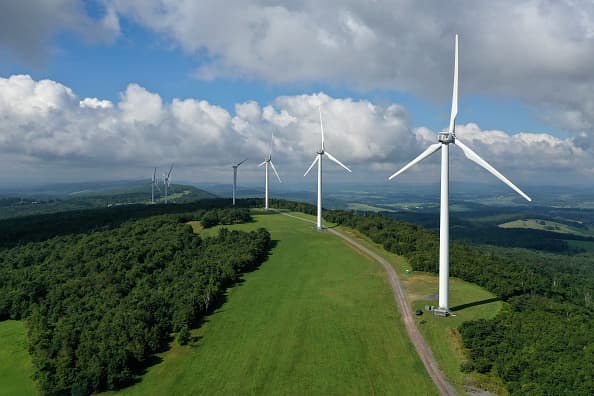
The utilities sector is living in the shadows of mega-cap tech, but a power player name is emerging — and it’s toting year-to-date gains of more than 40%. Constellation Energy , headquartered in Baltimore, is the top winner in the utilities sector in 2024, with NRG Energy in a distant second place with a 22.7% advance. The gains come at a time when high interest rates continue to weigh on utilities, raising the companies’ refinancing costs and making these classic dividend payers less competitive against the attractive yields investors can earn on Treasurys. Indeed, the utilities sector and real estate are the two laggards of the S & P 500 , down about 1% and 3.5% in 2024, respectively. CEG XLU 1Y line Constellation Energy versus the Utilities Select Sector SPDR Fund over the past year Constellation, which currently has a dividend yield of 0.8%, isn’t your father’s utility. Analysts covering the name are largely bullish on it, with about 62% of them rating it a buy or strong buy, per LSEG. But their price targets suggest shares could slip roughly 3% from here. Constellation, which produces energy through nuclear power plants, along with hydro, wind and solar, is a green energy play and a beneficiary of the Inflation Reduction Act. “We see CEG as a differentiated story given its position as the largest producer of carbon-free generation, low leverage and burgeoning clean product strategy that will enable its customers to accelerate their own decarbonization goals, including the potential for large-scale hydrogen production,” wrote BMO Capital Markets analyst James Thalacker in a Feb. 28 report. A spinoff stands on its own Constellation is the result of a 2022 spinoff from utility giant Exelon , whose smaller utilities include Atlantic City Electric, Baltimore Gas and Electric and Delmarva Power & Light. The spun-off company now provides 10% of the country’s carbon-free electricity and has more than 32,400 megawatts of capacity. What investors love about it — and what’s driving the stock’s price appreciation as of late — is the hefty amounts of cash that’s being returned to shareholders. In late February, Constellation posted its fourth-quarter results, beating analysts’ expectations for adjusted earnings before interest, taxes, depreciation, and amortization. But the real newsmaker was the company’s forward guidance: Constellation is calling for adjusted earnings ranging from $7.23 to $8.03 per share for the full year, compared to analysts’ forecasts for $6.51 per share. The company also announced a plan to hike its per-share dividends by 25%, exceeding its 10% annual dividend growth target, and it started its next $1 billion in share repurchases. Just last year, Constellation completed its first $1 billion stock repurchase plan. It’s also sitting on a pile of cash. The company has about $3.1 billion to $3.5 billion of unallocated capital over the next two years, CFO Daniel Eggers said on the company’s Feb. 27 earnings call. Data center drivers The prospects are looking rosy in the long run, with Constellation targeting long-term base earnings per share growth of at least 10% through the decade. This will be backstopped by the nuclear production tax credit in the Inflation Reduction Act, along with the company’s free cash flow generation. The update was enough to spur KeyBanc analyst Sophie Karp into upgrading shares to overweight from sector weight with a price target of $190 per share. “CEG has laid out a convincing growth algorithm, underpinned by the existing policy framework and trends, which we think offers much more clarity, and solidly positions CEG as one of the premium infrastructure names in our coverage,” she wrote in a Feb. 27 report. There are other drivers lifting shares higher, too. BMO’s Thalacker pointed to potential margin expansion opportunities tied to data center demand and 24/7 carbon-free power. So-called 24/7 carbon-free power involves purchasing electricity generation from the same region where a corporate client will use it. This matching can occur on an hourly basis. Last June, Constellation reached an agreement with Microsoft to power one of the tech giant’s data centers in Virginia, using the utility’s hourly carbon-free energy matching platform. Data center demand, especially as artificial intelligence proliferates, will spur a greater need for electricity – and in particular, carbon-free power to meet environmental policy goals. “Today, it’s not uncommon to see 100-megawatt data centers,” said CEO Joseph Dominguez on the company’s latest earnings call. “And with our clients, we’re talking about data centers that approach 1,000 megawatts, and they require 24/7 power.” And the Street is noticing the power of data center demand. “CEG’s outlook has further upside, particularly from higher inflation, higher power prices, and premium pricing for clean/reliable nuclear through 24×7 product and data centers on site,” wrote Steve Fleishman of Wolfe Research on Feb. 28. He rates the stock as outperform and has a price target of $177. “The upside is meaningful,” he added. “For instance, assuming 3% vs 2% inflation raises CEG’s 2028 revenue by $755M.” Potential legislative risk The worry that’s on the mind of investors in companies with a renewable focus is whether the IRA, along with the nuclear production tax credit, could be threatened in the 2024 election. Republican lawmakers have opposed the legislation and have threatened to repeal it. Analysts think that while it’s a possibility, a repeal of the legislation is probably unlikely. “Republicans would have to gain majorities in both Congressional chambers, and come to a consensus on legislation,” wrote UBS analyst Ross Fowler in a March 4 report. “The expiration of the [production tax credit] in 2032 absent renewal also makes it easier to include in any budget reconciliation negotiations.”







